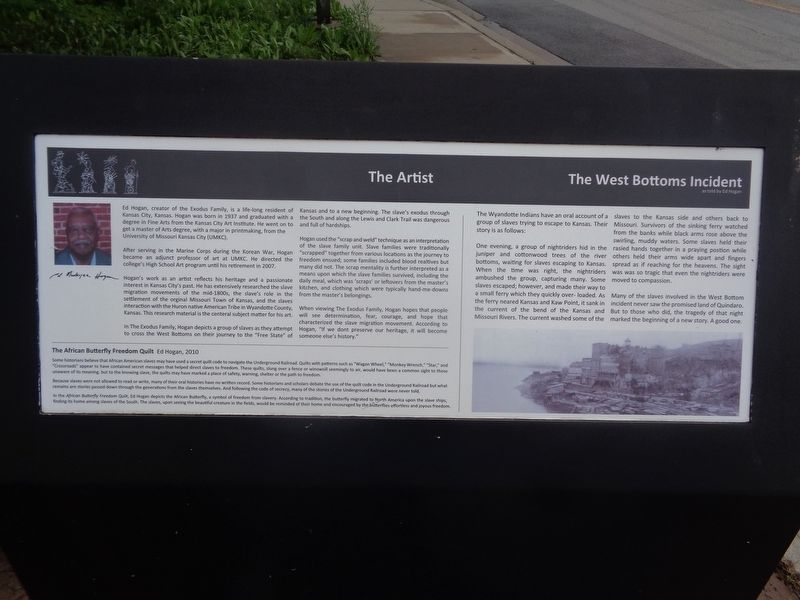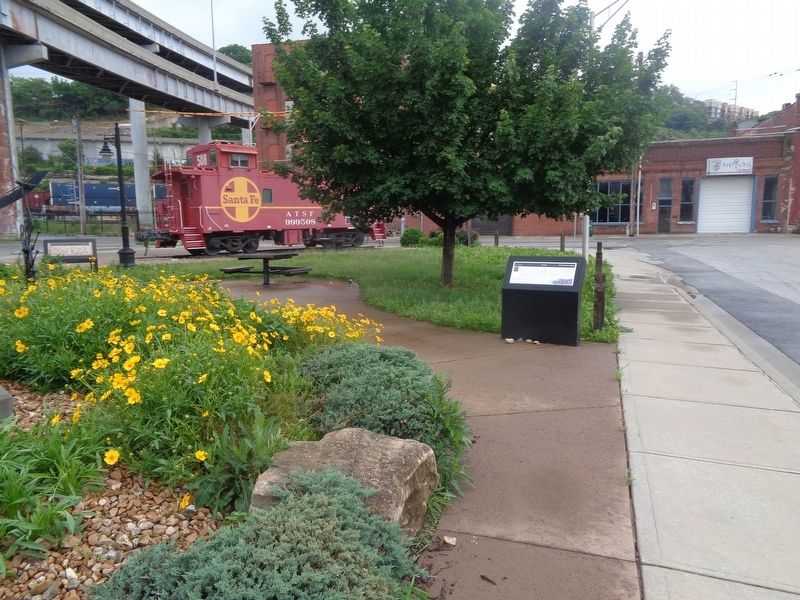Downtown Kansas City in Jackson County, Missouri — The American Midwest (Upper Plains)
Ed Hogan
The Artist
Ed Hogan, creator of the Exodus Family, is a life-long resident of Kansas City, Kansas. Hogan was born in 1937 and graduated with a degree in Fine Arts from the Kansas City Art Institute. He went on to get a master of Arts degree, with a major in printmaking, from the University of Missouri Kansas City (UMKC).
After serving in the Marine Corps during the Korean War, Hogan became an adjunct professor of art at UMKC. He directed the college's High School Art program until his retirement in 2007.
Hogan's work as an artist reflects his heritage and a passionate interest in Kansas City's past. He has extensively researched the slave migrations movements of the mid-1800s, the slave's role in the settlement of the original Missouri Town of Kansas, and the slaves interaction with the Huron native American Tribe in Wyandotte County, Kansas. This research material is the centeral subject matter for his art.
In the Exodus Family, Hogan depicts a group of slaves as they attempt to cross the West Bottoms on their journey to the "Free State" of Kansas and to a new beginning. The slave's exodus through the South and along the Lewis and Clark Trail was dangerous and full of hardships.
Hogan used the "scrap and weld" technique as an interpolation of the slave family unit. Slave families were traditionally "scrapped" together from various locations as the journey to freedom ensued; some families included blood relatives but many did not. The scrap mentality is further interpreted as a means upon which the slave families survived, including the daily meal, which was 'scraps' or leftovers from the master's kitchen, and clothing which were typically hand-me-downs from the master's belongings.
When viewing The Exodus Family, Hogan hopes that people will see determination, fear, courage, and hope that characterized the slave migration movement. According to Hogan, "if we don't preserve our heritage, it will become someone else's history."
The West Bottoms Incident
as told by Ed Hogan
The Wyandotte Indians have an oral account of a group of slaves trying to escape to Kansas. Their story is as follows:
One evening, a group of nightriders hid in the juniper and cottonwood trees of the river bottoms, waiting for slaves escaping to Kansas. When the time was right, the nightriders ambushed the group, capturing many. Some slaves escaped; however, and made their way to a small ferry which they quickly over-loaded. As the ferry neared Kansas and Kaw Point, it sank in the current of the bend of the Kansas and Missouri Rivers. The current washed some of the slaves to the Kansas side and others back to Missouri. Survivors of the sinking ferry watched from the banks while black arms rose above the swirling, muddy waters. Some slaves held their raised hands together in a praying position while others held their arms wide apart and fingers spread as if reaching for the heavens. The sight was so tragic that even the nightriders were moved to compassion.
Many of the slaves involved in the West Bottom incident never saw the promised land of Quindaro. But to those who did, the tragedy of that night marked the beginning of a new story. A good one.
The African Butterfly Freedom Quilt
Some historians believe that African American slaves may have used a secret quilt code to navigate the Underground Railroad. Quilts with patterns such as "Wagon Wheel," "Monkey Wrench," "Star," and "Crossroads" appear to have contained secret messages that helped direct slaves to freedom. These quilts, slung over a fence or windowsill seemingly to air, would have been a common sight to those unaware of its meaning, but to the knowing slave, the quilts may have marked a place of safety, warning, shelter or the path to freedom.
Because slaves were not allowed to read or write, many of their oral histories have no written record. Some historians and scholars debate the use of the quilt code in the Underground Railroad but what remains are stories passed down through the generations from the slaves themselves. And following the code of secrecy, many of the stories of the Underground Railroad were never told.
In the African Butterfly Freedom Quilt, Ed Hogan depicts the African Butterfly, a symbol of freedom from slavery. According to tradition, the butterfly migrated to North America upon the slave ships, finding its home among slaves of the South. The slaves, upon seeing the beautiful creature in the fields, would be reminded of their home and encouraged by the butterflies effortless and joyous freedom.
Topics. This historical marker is listed in these topic lists: Abolition & Underground RR • African Americans • Arts, Letters, Music. A significant historical year for this entry is 1937.
Location. 39° 6.374′ N, 94° 35.696′ W. Marker is in Kansas City, Missouri, in Jackson County. It is in Downtown Kansas City. Marker is on Madison Street north of West 8th Street, on the left when traveling south. Marker is located at Train Park. Touch for map. Marker is at or near this postal address: 751 Madison St, Kansas City MO 64101, United States of America. Touch for directions.
Other nearby markers. At least 8 other markers are within walking distance of this marker. Slavery in Kansas City (a few steps from this marker); Frontier Railroads in Kansas City (within shouting distance of this marker); Darby Trotter Spirit Mall (within shouting distance of this marker); Etienne Veniard - Sieur de Bourgemont (approx. 0.2 miles away); Lewis and Clark Expedition Across Missouri (approx. 0.2 miles away); The French and the Lewis & Clark Expedition (approx. 0.2 miles away); James Pendergast (approx. 0.2 miles away); Lewis and Clark (approx. 0.2 miles away). Touch for a list and map of all markers in Kansas City.
Regarding Ed Hogan. Edward Hogan passed away on November 21, 2013, at the age of 76.
Credits. This page was last revised on February 10, 2023. It was originally submitted on June 4, 2022, by Jason Voigt of Glen Carbon, Illinois. This page has been viewed 180 times since then and 26 times this year. Photos: 1, 2. submitted on June 4, 2022, by Jason Voigt of Glen Carbon, Illinois.

